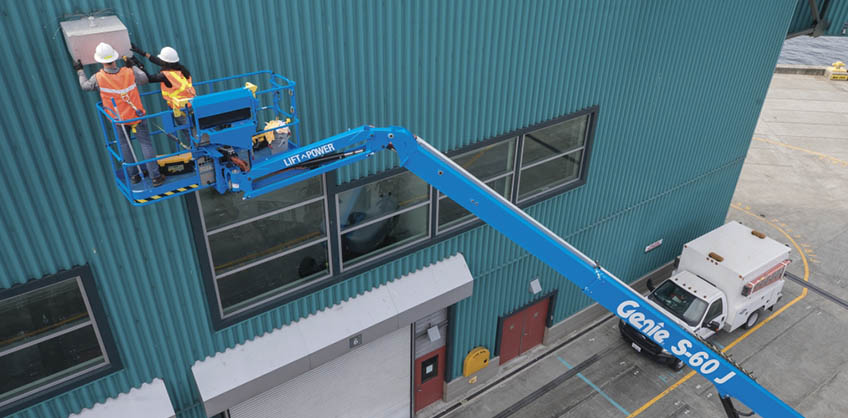Understanding Fall Protection Requirements
by Scott Owyen - Director of Training On May 28, 2020, 03:00 AM
Subscribe To Aerial Pros
Filter by tags
Spelled out in the updated ANSI A92 and CSA B354 standards, as well as the OSHA and OHS requirements, fall protection on mobile elevating work platform (MEWPs) is required in the United States and Canada. A $132,598 fine for a willful violation from OSHA should be enough to make most jobsites pay attention to these requirements. But, making sure that the men and women who operate MEWPs as part of their daily operation are safe, well-protected, and that they are able to go home at the end of the day in the same condition they were in when they left for work that morning, must be the number one priority.
The best way to make sure that everyone on an aerial jobsite is in compliance with these requirements is for everyone to be aware of — and understand more — about them.
Let’s start with a general summary of fall protection requirements for Group B MEWPs:
- The user is responsible for providing approved fall protection for employees1.
- A personal fall arrest system used on a boom type MEWP cannot allow the operator to fall more than 6 ft2.
- A personal fall arrest system used on a boom type MEWP cannot allow the operator to come into contact with any lower surface2.
These points are so critical that it is important to address more in-depth.
Not only is the user responsible for providing approved fall protection for all MEWP occupants, they must also ensure that the PFPE is inspected for wear prior to each use by the operator, as well as by a competent person other than the operator at intervals of no more than one year. The user is also responsible for ensuring that anyone who is required to use PFPE has been trained on how to properly put on and adjust the equipment and how to use it, as well as how and where to attach the lanyard/SRL to the MEWP.
Always remember that the platform guardrails are not approved attachment anchors for PFPE. Only designated anchors may be used for PFPE. For example, all anchor locations on Genie® booms and scissor lifts are designed to hold 16 kN (3,597 lbf) static load.
Safe and appropriate use of personal fall protection equipment on any MEWP is the responsibility of the operator and user/employer and is accomplished by strict conformance to governing regulations, the operator’s manual, ANSI Manual of Responsibilities and safety decals found on the machine.
Ensuring that the personal fall arrest system used cannot allow the operator to fall more than 6 ft or allow the operator to come into contact with any lower surface (the ground or any surface that they may be rotated over) is absolutely critical to the safety of the operator.
However, in 2009, OSHA came to the conclusion that operators could potentially be seriously or fatally injured during an ejection from the platform while wearing a 6-ft shock-absorbing lanyard (since one of the most common instances of an ejection is while driving the machine in the stowed position on rough terrain) and released a letter of interpretation stating that such lanyards alone could not meet the requirements for fall protection in certain situations.3
Clearly, a 6-ft lanyard will not stop the operator from striking the ground. In addition, they reviewed the variables that may affect the effective stopping distance of that same lanyard if the operator were to fall from height. They determined that a typical 6-ft tall operator would have to be at least 18.5 ft above the working surface for a 6-ft lanyard to effectively stop a fall.3
It is critical to understand how they arrived at this very important conclusion.
Let’s imagine that there is a 6-ft tall operator, and he/she is wearing a 6-ft shock-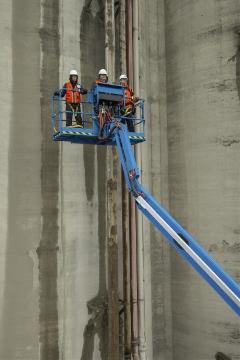 absorbing lanyard that is attached to his/her dorsal D-ring and an appropriate anchor point that is typically located at the mid-rail of the MEWP platform.
absorbing lanyard that is attached to his/her dorsal D-ring and an appropriate anchor point that is typically located at the mid-rail of the MEWP platform.
Now imagine that, due to a fall or ejection event, the operator has been discharged from the platform. Between the total length of the lanyard (6 ft), the total length of the deployed shock-absorbing pack on the lanyard (3-1/2 ft), the distance between the dorsal D-ring on the operator’s harness and his/her feet (~4-1/2 ft), the stretch of the harness at the end of the fall (~1-1/2 ft) and the deflection of the MEWP platform at the end of the fall (~3 ft), the operator could potentially fall 18.5 ft before effectively coming to a stop.
When OSHA says that a personal fall arrest system used on a boom type MEWP cannot allow the operator to come into contact with any lower surface, the implication is that every operator and occupant in the platform will have to be responsible for determining what is called their minimum fall distance calculation.
When calculating the total fall distance the operator must take into consideration the following:
- Lanyard free fall distance
- Maximum allowable deceleration distance
- Maximum lock‐up length(for the self-retracting lifeline/lanyard only)
- The height of the operator
- Safety factor (a suitable amount to ensure thatthe required clearance between the operator andthe lower surface is met)
- Any stretch in the lifeline or lanyard outsideof the deceleration distance.
- Any harness effects
- Any movement of the platform due to dynamic loading
- Any obstructions under the platform
Clearly this calculation will be different for each operator/occupant and is a critical component to ensuring their safety when working at height.
During travel in the stowed position and whenever the platform height is below the calculated total fall distance (or whenever they are above the calculated total fall distance):
- The operator and all occupants must wear a full body harness with either a fall restraint system or 6-ft maximum length self-retracting lifeline (which has been approved for use on a MEWP by the manufacturer);
or
- A full body harness with a double lanyard system (fall arrest and fall restraint)
- The fall restraint lanyard must be used during travel in the stowed position and when the platform height is below the calculated total fall distance.
- The fall arrest lanyard can be used when the platform height is above the calculated total fall distance and when all other factors have been taken into consideration.
- It is no longer acceptable to place two double-locking snap hooks to a single D-ring. When using a double lanyard system, such as the one mentioned here, MEWP occupants must use a D-ring extension to separate the two devices. Never use a side d-ring for fall arrest;
The key takeaway from all of the information above is that it is never acceptable to use a 6-ft shock-absorbing lanyard by itself when operating a Group B MEWP. It is important that each MEWP occupant is equipped with the proper fall protection equipment as outlined in this article. Even if MEWP operators are loading or unloading a truck, moving the machine in the yard or other tasks, it is critical that each person is properly protected.
1OSHA Title 29 CFR 1926.501(a)(1)
2OSHA Title 29 CFR 1926.502(d)(16)(iii)
3January 14, 2009 Interpretation Letter # 20070823-7896
Related Posts
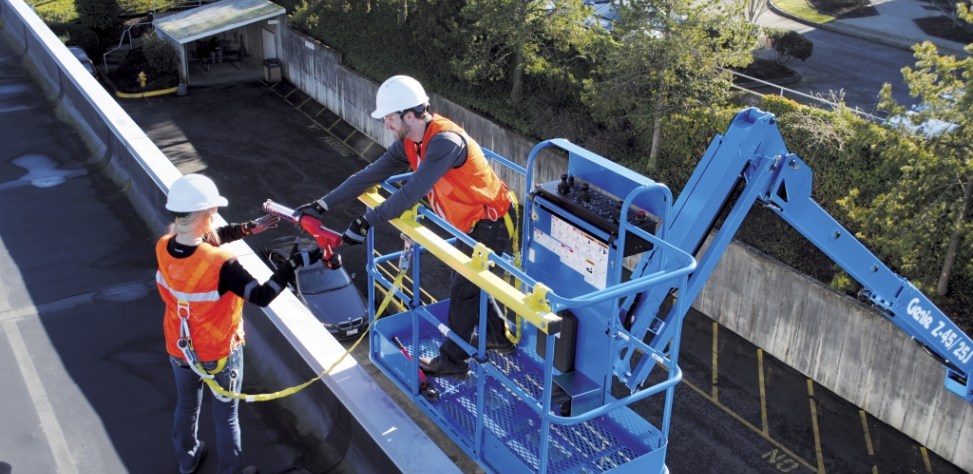
Why the Genie® Fall Arrest Bar Allows Safe Exit and Work Around Access
Articulating and telescopic booms are designed to carry personnel to elevated work locations.
Continue Reading
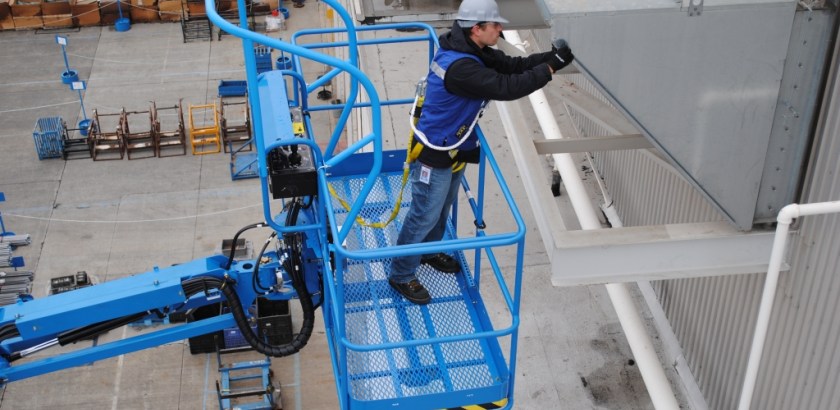
OSHA National Safety Stand-Down 2018: What are the Fall Protection Requirements When Operating an Aerial Work Platform?
The number one priority on any aerial jobsite should be to promote a safe workplace for both the operators and the equipment.
Continue Reading
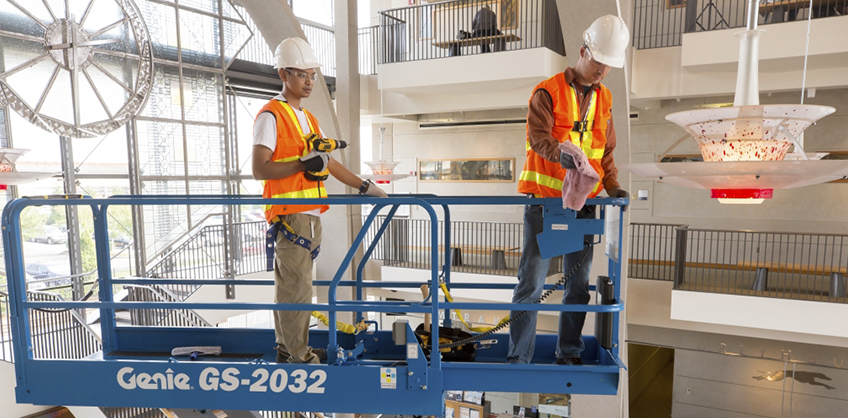
Clearing Up the Confusion: Fall Protection Requirements on Group B MEWPs
When it comes to using fall protection equipment for on mobile elevating work platforms (MEWPs), many still do not fully understand, or comprehend, the requirements in the ANSI A92 and CSA B354 standards, as well as the OSHA and OHS requirements, for fall protection on MEWPs in the United States and Canada.
Continue Reading


